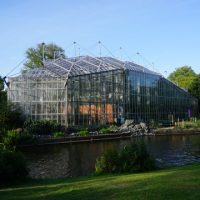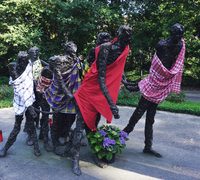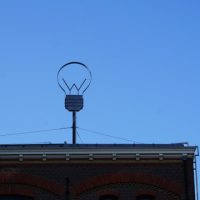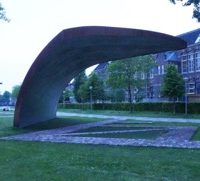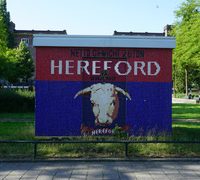Portrait of Jan Pieterszoon Coen
Mauritskade
In the summer of 2017 the media were full of the ideological battle going on regarding controversial statues of heroes of the US Civil War. Demonstrators held opposing views on the respect due to the men who had devoted themselves to the maintenance of slavery. Statues were daubed with paint or defended, or removed by the local authorities as a preventive measure.
The struggle against the omnipresence in the public space of historical colonists and White supremacists has also resurfaced in the Netherlands. Hundreds of streets in Amsterdam bear the names of controversial naval heroes and their faces adorn a variety of buildings. An example is this one, on a relief above the main entrance of the Tropenmuseum where the Dutch East India Company (VOC) merchant Jan Pieterszoon Coen stands guard. The relief was probably made by J.L. Vreugde, although various artists contributed to it. A special symbolism committee chose the decorations.
The Tropenmuseum opened in 1926 as the Colonial Institute. It was the keeper of the ethnographic collection that was brought back from the colonies. The façade reliefs refer to the Golden Age when the Netherlands built up its empire overseas. In 1621 Coen led massacre on the Banda islands. By the time a revolt against the imposition of a Dutch monopoly on nutmeg had been crushed, only six hundred of the fifteen thousand islanders were left with their lives. This slaughter was condemned even in Coen’s own time, but in the nationalist nineteenth century he was praised as a hero of the Golden Age and founder of the worldwide Dutch empire. Now this status is called into question again. Does a man like Coen deserve such an honourable position in our city?
The questions raised by this debate require a critical view of art in the public space. Which history do the streets of Amsterdam tell? For whom was this history glorious, for whom inglorious? Should the symbolism in a city stand for all its diverse residents? For instance, is it a problem that so few streets are named after women? And can symbolism really have an impact on the psyche of the women of Amsterdam today? And if not, do we still have the responsibility to keep the ideology of a city up to date? What do we do if we change our minds about the heroic deeds that we once honoured?
‘History is written by the victors’, claimed the former British premier Winston Churchill in the 1960s. The Coen Tunnel, the former Van Heutsz Monument, the Piet Heinkade: Amsterdam tells the glorious story of the Golden Age when the city was the hub of international trade. It is no secret that the era also had its shadow side. The Netherlands, like many other European countries, owed its wealth to the exploitation and enslavement of people in other continents. It is partly as a result of this history that the Amsterdam of today is a diverse, multicultural city. The current debate on whether or not to remove statues and street names of oppressors is about representation. What do we as a city want to express, what do we stand for, and which citizens are represented in the public space?
This year the former J.P. Coen school in East Amsterdam gave a loud and clear answer to this question by dropping the name. It is now trying to find a name that everyone in the school can support and that represents the multicultural composition of the school community. Still, different answers are possible in this complicated issue. Decolonisation is more than just breaking the colonial relation between oppressor and oppressed. It is a process in which the colonial legacy, consisting of centuries of superiority in all its forms, is due for revision. The Tropenmuseum itself has developed a critical attitude towards its institutional history and assumed an active role in the process of decolonisation. In exhibitions and symposia the collection is considered as material that can offer an honest and balanced perspective on the imperialist history. In this connection the exhibitions Present of the slave pastand Afrofuturismcan currently be seen in the Tropenmuseum.




